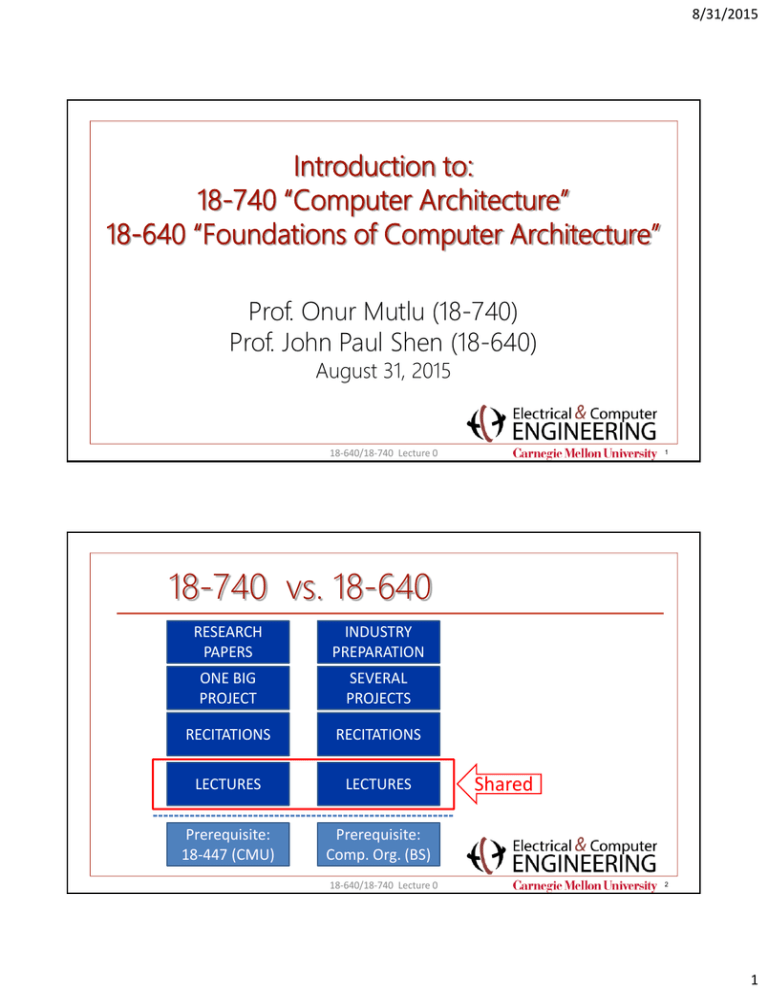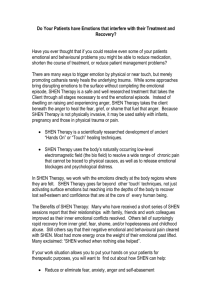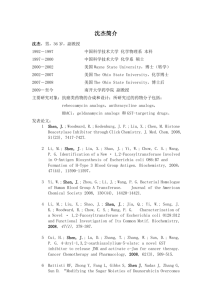18-740 vs. 18-640 Introduction to: 18-740 “Computer Architecture”
advertisement

8/31/2015 Introduction to: 18-740 “Computer Architecture” 18-640 “Foundations of Computer Architecture” Prof. Onur Mutlu (18-740) Prof. John Paul Shen (18-640) August 31, 2015 18-640/18-740 Lecture 0 1 18-740 vs. 18-640 RESEARCH PAPERS INDUSTRY PREPARATION ONE BIG PROJECT SEVERAL PROJECTS RECITATIONS RECITATIONS LECTURES LECTURES Prerequisite: 18-447 (CMU) Prerequisite: Comp. Org. (BS) 18-640/18-740 Lecture 0 Shared 2 1 8/31/2015 18-740 Instructor: Onur Mutlu Associate Professor @ Carnegie Mellon University ECE/CS PhD from UT-Austin 2006, BS from Michigan 2000 Past experience @ Microsoft Research, Intel, AMD omutlu@gmail.com (Best way to reach me) http://www.ece.cmu.edu/~omutlu http://users.ece.cmu.edu/~omutlu/projects.htm Research and Education in Computer architecture and systems, bioinformatics Memory and storage systems, emerging technologies Many-core systems, heterogeneous systems, core design Interconnects Hardware/software interaction and co-design (PL, OS, Architecture) Predictable and QoS-aware systems Hardware fault tolerance and security Algorithms and architectures for genome analysis … 3 18-740 Teaching Assistant: Nandita Nandita Vijaykumar Office hours and locations will be posted online PhD student with Onur Mutlu BE from PES Inst. Of Technology 2011 Past experience @ AMD nandita@cmu.edu http://www.ece.cmu.edu/~ece740/f15 Reach all of us at 740-official@ece.cmu.edu 4 2 8/31/2015 18-640 Cast of Characters Instructor: John Paul Shen (SV) Academic Services Assistants: Zara Collier (PGH) Stephanie Scott (SV) Teaching Assistants: Priyank Sanghavi (PGH) Guanglin Xu (PGH) Adeola Bannis (SV) Revathy Shunmugam (PGH) • Cover PGH & SV sections • Cover GZ & PGH sections • Cover SV section • Cover PGH & GZ sections JIE Course Coordinator: Ziyan He (GZ) 18-640/18-740 Lecture 0 5 My Personal Background: Academia • Carnegie Mellon University • First Half Computer Aided Design • Second Half Computer Architecture • Sabbatical at Stanford • Sabbatical at Intel Industry • Intel, Research Lab • Microarchitecture Lab Microprocessor Design • North America Lab Mobile Computing System • Nokia, Research Center 18-640/18-740 Lecture 0 6 3 8/31/2015 18-640/18-740 Computer Architecture Lecture 1: “Introduction To Computer Architecture” John Paul Shen August 31, 2015 Required Reading Assignment: • Chapters 1 and 2 of Shen and Lipasti (SnL). Recommended References: “Amdahl’s and Gustafson’s Laws Revisited” by Andrzej Karbowski. (2008) “High Performance Reduced Instruction Set Processors” by Tilak Agerwala and John Cocke. (1987) 8/31/2015 (©J.P. Shen) 18-640/18-740 Lecture 1 7 18-640/18-740 Computer Architecture Lecture 1: “Introduction To Computer Architecture” A. Instruction Set Architecture (ISA) a. Hardware / Software Interface b. Dynamic / Static Interface (DSI) B. Historical Perspective on Computing a. Major Epochs b. Processor Performance Iron Law (#1) c. Course Coverage C. “Economics” of Computer Architecture a. Amdahl’s Law and Gustafson’s Law b. Moore’s Law and Bell’s Law 8/31/2015 (©J.P. Shen) 18-640/18-740 Lecture 1 8 4 8/31/2015 Anatomy of Engineering Design Specification: Behavioral description of “What does it do?” Synthesis: Search for possible solutions; pick best one. Creative process Implementation: Structural description of “How is it constructed?” Analysis: Validate if the design meets the specification. “Does it do the right thing?” + “How well does it perform?” 8/31/2015 (©J.P. Shen) 18-640/18-740 Lecture 1 9 Lecture 1: “Introduction to Computer Architecture” A. Instruction Set Architecture (ISA) a. Hardware / Software Interface b. Dynamic / Static Interface (DSI) 8/31/2015 (©J.P. Shen) 18-640/18-740 Lecture 1 10 5 8/31/2015 The Classic Von Neumann Computation Model • Proposed in 1945 by John Von Neumann and others (Alan Turing, J. Presper Eckert and John Mauchly). • A “Stored Program Computer” 1. One CPU • One Control Unit • Program Counter • Instruction Register • One ALU 2. Monolithic Memory • Data Store • Instruction Store 3. Sequential Execution Semantics 8/31/2015 (©J.P. Shen) 18-640/18-740 Lecture 1 11 Computer Architecture: Instruction Set Architecture Application Software • Program development • Program compilation SPECIFICATION Instruction-Set Processor Design Instruction Set Architecture (ISA) Hardware Technology • Program execution • Machine performance IMPLEMENTATION 8/31/2015 (©J.P. Shen) 18-640/18-740 Lecture 1 12 6 8/31/2015 [Gerrit Blaauw & Fred Brooks, 1981] Art and Science of Instruction Set Processor Design ARCHITECTURE (ISA) programmer/compiler view • Functional programming model to application/system programmers • Opcodes, addressing modes, architected registers, IEEE floating point IMPLEMENTATION (μarchitecture) processor designer view • Logical structure or organization that performs the ISA specification • Pipelining, functional units, caches, physical registers, buses, branch predictors REALIZATION (Chip) chip/system designer view • Physical structure that embodies the implementation • Gates, cells, transistors, wires, dies, packaging 8/31/2015 (©J.P. Shen) 18-640/18-740 Lecture 1 13 Computer Architecture: Dynamic-Static Interface Windows 7 Visual C++ PROGRAM “static” Firefox, MS Excel Architectural state requirements: • Support sequential instruction execution semantics. • Support precise servicing of exceptions & interrupts. Architectural State Exposed to SW x86 Machine Primitives Logic Gates & Memory Transistors & Devices Quantum Physics “dynamic” ARCHITECTURE Dynamic/Static Interface (DSI)=(ISA) Von Neumann Machine MACHINE Microarchitecture State Hidden in HW Buffering needed between arch and uarch states: • Allow uarch state to deviate from arch state. • Able to undo speculative uarch state if needed. DSI = ISA = a contract between the program and the machine. 8/31/2015 (©J.P. Shen) 18-640/18-740 Lecture 1 14 7 8/31/2015 RISC vs. CISC [ Josh Fisher, HP] Transition from CISC to RISC: CISC High Level Lang. CISC Object Code MicroCode Stream Execution Hardware Missing Execution Hardware DSI RISC High Level Lang. 8/31/2015 (©J.P. Shen) RISC Object Code MicroCode 18-640/18-740 Lecture 1 15 Another way to view RISC RISC High Level Lang. Execution Hardware RISC Object Code DSI RISC? CISC? VLIW? 8/31/2015 (©J.P. Shen) High Level Lang. Missing Macro Code Compiled Ve rtical Micro Code 18-640/18-740 Lecture 1 Execution Hardware 16 8 8/31/2015 [B. Rau & J. Fisher, 1993] HW vs. SW and Dynamic vs.Static Design Space Front end & Optimizer Determine Depend. Dependence Architecture (Dataflow) Determine Depend. Determine Independ. Determine Independ. Independence Architecture VLIW Bind Resources Independence Architecture (Attached Array Processor) Compiler 8/31/2015 (©J.P. Shen) Hardware Sequential (Superscalar) Bind Resources Execute 18-640/18-740 Lecture 1 17 Lecture 1: “Introduction to Computer Architecture” B. Historical Perspective on Computing a. Major Epochs b. Processor Performance Iron Law (#1) c. Course Coverage 8/31/2015 (©J.P. Shen) 18-640/18-740 Lecture 1 18 9 8/31/2015 Almost Seven Decades of Modern Computing . . . Mainframes Minicomputers Personal Computers Laptop Computers Eniac (1946) Mobile Computers ??? 8/31/2015 (©J.P. Shen) 18-640/18-740 Lecture 1 19 Historical Perspective on the Last Five Decades "Computer Architecture Foundations" Von Neumann computation model, programming languages, compilers, OS’s • Commercial Mainframe computers, Scientific numerical computers "Birth of Microprocessors" • The Decade of the 1970's: • Programmable controllers, bit-sliced ALU’s, single-chip processors • Emergence of Personal Computers (PC) • The Decade of the 1960's: • • The Decade of the 1980's: • • • The Decade of the 1990's: • • • "Quantitative Architecture" Instruction pipelining, fast cache memories, compiler considerations Widely available Minicomputers, emergence of Personal Workstations "Instruction-Level Parallelism" Superscalar, speculative microarchitectures, aggressive compiler optimizations Widely available low-cost desktop computers, emergence of Laptop computers The Decade of the 2000's: • • "Mobile Computing Convergence" Multi-core architectures, system-on-chip integration, power constrained designs Convergence of smartphones and laptops, emergence of Tablet computers 8/31/2015 (©J.P. Shen) 18-640/18-740 Lecture 1 20 10 8/31/2015 Intel 4004, circa 1971 The first single chip CPU • • • • • • 4-bit processor for a calculator. 1K data memory 4K program memory 2,300 transistors 16-pin DIP package 740kHz (eight clock cycles per CPU cycle of 10.8 microseconds) • ~100K OPs per second Molecular Expressions: Chipshots 8/31/2015 (©J.P. Shen) 18-640/18-740 Lecture 1 21 Intel Itanium 2, circa 2002 Performance leader in floating-point apps • • • • 64-bit processor 3 MByte in cache!! 221 million transistor 1 GHz, issue up to 8 instructions per cycle In ~30 years, about 100,000 fold growth in transistor count! http://cpus.hp.com/images/die_photos/McKinley_die.jpg 8/31/2015 (©J.P. Shen) 18-640/18-740 Lecture 1 22 11 8/31/2015 Performance Growth in Perspective [ John Crawford, Intel, 1993] • Doubling every 18 months (1982-2000): • • • • total of 3,200X Cars travel at 176,000 MPH; get 64,000 miles/gal. Air travel: L.A. to N.Y. in 5.5 seconds (MACH 3200) Wheat yield: 320,000 bushels per acre • Doubling every 24 months (1971-2001): • • • • total of 36,000X Cars travel at 2,400,000 MPH; get 600,000 miles/gal. Air travel: L.A. to N.Y. in 0.5 seconds (MACH 36,000) Wheat yield: 3,600,000 bushels per acre Unmatched by any other industry!! 8/31/2015 (©J.P. Shen) 18-640/18-740 Lecture 1 23 Convergence of Key Enabling Technologies • CMOS VLSI: • Submicron feature sizes: 0.3u → 0.25u → 0.18u → 0.13u → 90n → 65n → 45n → 32nm… • Metal layers: 3 → 4 → 5 → 6 → 7 (copper) → 12 … • Power supply voltage: 5V → 3.3V → 2.4V → 1.8V → 1.3V → 1.1V … • CAD Tools: • Interconnect simulation and critical path analysis • Clock signal propagation analysis • Process simulation and yield analysis/learning • Microarchitecture: • Superpipelined and superscalar machines • Speculative and dynamic microarchitectures • Simulation tools and emulation systems • Compilers: • Extraction of instruction-level parallelism • Aggressive and speculative code scheduling • Object code translation and optimization 8/31/2015 (©J.P. Shen) 18-640/18-740 Lecture 1 24 12 8/31/2015 “Iron Law” of Processor Performance Time 1/Processor Performance = --------------Program = Instructions -----------------Program (inst. count) Cycles X ---------------Instruction X (CPI) Time -----------Cycle (cycle time) Architecture Implementation Realization Compiler Designer 8/31/2015 (©J.P. Shen) Processor Designer Chip Designer • In the 1980’s (decade of pipelining): • CPI: 5.0 1.15 • In the 1990’s (decade of superscalar): • CPI: 1.15 0.5 (best case) • In the 2000’s: • we learn the power lesson 18-640/18-740 Lecture 1 25 Landscape of Processor Families [SPECint92] 8/31/2015 (©J.P. Shen) 18-640/18-740 Lecture 1 26 13 8/31/2015 Landscape of Processor Families [SPECint95] Landscape of Microprocessor Families (SPECint95) 0.08 35 30 25 0.07 40 45 50 55 60 SPECint 95 20 15 0.06 264 SPECint95/MHz 10 0.05 0.04 PII PIII PPro 0.03 PIII Athlon 5 Athlon 164 Pentium 0.02 Alpha 064 AMD-x86 0.01 Intel-x86 0 80 180 280 380 480 580 680 Frequency (MHz) 18-640/18-740 Lecture 1 8/31/2015 (©J.P. Shen) 780 880 980 ** Data source www.spec.org 27 Landscape of Processor Families [SPECint2000] Landscape of Microprocessor Families (SPECint2K) 1 Intel-x86 AMD-x86 Alpha PowerPC Sparc IPF 300 400 500 600 700 800 SPECint 2000 200 SPECint2000/MHz 100 50 25 264B PIII-Xeon 264C Sparc-III 0.5 Athlon Itanium 604e Pentium 4 264A 0 0 8/31/2015 (©J.P. Shen) 500 1000 1500 Frequency (MHz) 18-640/18-740 Lecture 1 2000 2500 ** Data source www.spec.org 28 14 8/31/2015 Iron Law #1 – Processor (Latency) Performance Time to execute a program: T (latency) T instructions cycles time program instruction cycle T PathLength CPI CycleTime Processor performance: Perf = 1/T Perf CPU 1 Frequency PathLength CPI CycleTime PathLength CPI 8/31/2015 (©J.P. Shen) 18-640/18-740 Lecture 1 29 [John DeVale & Bryan Black, 2005] Landscape ofLandscape Processor Families Families [SPECint2000] of Microprocessor 1 1300 1100 1700 1900 SpecINT 2000 Intel-x86 1500 900 500 700 300 AMD-x86 Itanium Power5 Power 100 DTN Power 3 0.5 PIII Power4 Opteron PerformanceCPU Athlon Frequency PathLength CPI Extreme 800 MHz PSC NWD P4 Wider pipeline SPECint2000/MHz Itanium Deeper pipelining 0 0 500 1000 Source: www.SPEC.org 8/31/2015 (©J.P. Shen) 1500 2000 Frequency (MHz) 18-640/18-740 Lecture 1 2500 3000 3500 ** Data source www.spec.org 30 15 8/31/2015 18-640/18-740 Course Coverage: Processor Designs Persistence of Von Neumann Model (Legacy SW Stickiness) 1. One CPU 2. Monolithic Memory 3. Sequential Execution Semantics Evolution of Von Neumann Implementations: • SP: PP: SSP: MCP: SMP: Sequential Processors (direct implementation of sequential execution) Pipelined Processors (overlapped execution of in-order instructions) Superscalar Processors (out-of-order execution of multiple instructions) Multi-core Processors = CMP: Chip Multiprocessors (concurrent multi-threads) Symmetric Multiprocessors (concurrent multi-threads and multi-programs) 8/31/2015 (©J.P. Shen) 18-640/18-740 Lecture 1 31 18-640/18-740 Course Coverage: Parallelism Exploited Persistence of Von Neumann Model (Legacy SW Stickiness) 1. One CPU 2. Monolithic Memory 3. Sequential Execution Semantics Parallelisms for Performance ( for Power Reduction for Energy Efficiency) ILP: ILP: DLP: TLP: PLP: 8/31/2015 (©J.P. Shen) Basic Block Loop Iteration Data Set Task/Thread Process/Program (exploit ILP in PP, SSP) (exploit ILP in SSP, VLIW) (exploit DLP in VP/SIMD, GPU) (exploit TLP in MCP) (exploit PLP in MCP, SMP) 18-640/18-740 Lecture 1 32 16 8/31/2015 Lecture 1: “Introduction to Computer Architecture” C. “Economics” of Computer Architecture a. Amdahl’s Law and Gustafson’s Law b. Moore’s Law and Bell’s Law 8/31/2015 (©J.P. Shen) 18-640/18-740 Lecture 1 33 “Economics” of Computer Architecture • Exercise in engineering tradeoff analysis • Find the fastest/cheapest/power-efficient/etc. solution • Optimization problem with 10s to 100s of variables • All the variables are changing • At non-uniform rates • With inflection points • Only one guarantee: Today’s right answer will be wrong tomorrow Two Persistent high-level “forcing functions”: Application Demand (PROGRAM) Technology Supply (MACHINE) 8/31/2015 (©J.P. Shen) 18-640/18-740 Lecture 1 34 17 8/31/2015 Four Foundational “Laws” of Computer Architecture Application Demand (PROGRAM) • Amdahl’s Law (1967) • Speedup through parallelism is limited by the sequential bottleneck • Gustafson’s Law (1988) • With unlimited data set size, parallelism speedup can be unlimited Technology Supply (MACHINE) • Moore’s Law (1965) • (Transistors/Die) increases by 2x every 18 months • Bell’s Law (1971) • (Cost/Computer) decreases by 2x every 36 months 8/31/2015 (©J.P. Shen) 18-640/18-740 Lecture 1 35 Amdahl’s Law • Speedup = (Execution time on Single CPU)/(Execution on N parallel processors) • ts /tp (Serial time is for best serial algorithm) N No. of Processors 1 h 1-h f 1-f Time • h = fraction of time in serial code • f = fraction that is vectorizable or parallelizable • N = max speedup for f 1 • Overall speedup 8/31/2015 (©J.P. Shen) Speedup (1 f ) 18-640/18-740 Lecture 1 f N 36 18 8/31/2015 Amdahl’s Law Illustrated • Speedup = timewithout enhancement / timewith enhancement • If an enhancement speeds up a fraction f of a task by a factor of N • timenew = timeorig·( (1-f) + f/N ) • Soverall = 1 / ( (1-f) + f/N ) timeorig time orig 1 - f) f (1 f timenew (1 - f) f/N 8/31/2015 (©J.P. Shen) f/N 18-640/18-740 Lecture 1 P (speedup) “Tyranny of Amdahl’s Law” 1 P = --------------------------------f 1 – f + ------ 50 37 [Bob Colwell, CMU-Intel-DARPA] • Suppose that a computation has a 4% serial portion, what is the limit of speedup on 16 processors? • 1/((0.04) + (0.96/16)) = 10 • What is the maximum speedup? • 1/0.04 = 25 (with N ) f (vectorizability) 8/31/2015 (©J.P. Shen) 18-640/18-740 Lecture 1 38 19 8/31/2015 From Amdahl’s Law to Gustafson’s Law • Amdahl’s Law works on a fixed problem size • This is reasonable if your only goal is to solve a problem faster. • What if you also want to solve a larger problem? • Gustafson’s Law (Scaled Speedup) • Gustafson’s Law is derived by fixing the parallel execution time (Amdahl fixed the problem size -> fixed serial execution time) • For many practical situations, Gustafson’s law makes more sense • Have a bigger computer, solve a bigger problem. • “Amdahl’s Law turns out to be too pessimistic for high-performance computing.” 8/31/2015 (©J.P. Shen) 18-640/18-740 Lecture 1 39 Gustafson’s Law • Fix execution of the computation on a single processor as • s + p = serial part + parallelizable part = 1 • Speedup(N) = (s + p)/(s + p/N) = 1/(s + (1 – s)/N) = 1/((1-p) + p/N) Amdahl’s law • Now let 1 = (a + b) = execution time of computation on N processors (fixed) where a = sequential time and b = parallel time on any of the N processors • Time for sequential processing = a + (b×N) and Speedup = (a + b×N)/(a + b) • Let α = a/(a+b) be the sequential fraction of the parallel execution time • Speedupscaled(N) = (a + b×N)/(a + b) = (a/(a+b) + (b×N)/(a+b)) = α + (1- α )N • If α is very small, the scaled speedup is approximately N, i.e. linear speedup. 8/31/2015 (©J.P. Shen) 18-640/18-740 Lecture 1 40 20 8/31/2015 The Two Laws on Algorithm and Performance Amdahl’s Law Speedup(N)MC Gustafson’s Law Speedup( N ) MC f * (1 f *) N 1 f 1 f 1 N f* = sequential fraction of total parallel execution time Execution Time Execution Time f = sequential % f 8/31/2015 (©J.P. Shen) f* Parallelism (N) Parallelism (N) 18-640/18-740 Lecture 1 41 The Two “Gordon” Laws of Computer Architecture Gordon Moore’s Law (1965) • (Transistors/Die) increases by 2X every 18 months • Constant price, increasing performance • Has held for 40+ years, and will continue to hold Gordon Bell’s Law (1971) • (Cost/Computer) decreases by 2X every 36 months (~ 10X per decade) • Constant performance, decreasing price • Corollary of Moore’s Law, creation of new computer categories “In a decade you can buy a computer for less than its sales tax today.” – Jim Gray We have all been living on this exponential curve and assume it… 8/31/2015 (©J.P. Shen) 18-640/18-740 Lecture 1 42 21 8/31/2015 Moore’s Law Trends • Moore’s Law for device integration • Chip power consumption • Single-thread performance trend 8/31/2015 (©J.P. Shen) [source: Intel] 18-640/18-740 Lecture 1 43 Bell’s Law Trends • 2X/3year = 10X/decade • 4X/3years = 100X/decade 8/31/2015 (©J.P. Shen) 18-640/18-740 Lecture 1 44 22 8/31/2015 [Bob Colwell CRA Grand Challenges panel 2005] Know Your “Supply & Demand Curves” $$$ 2004 “Speed at any price” “What’s in it for me?” -buyer Cell phones Ray tracing Portable computing Time “PC era” 8/31/2015 (©J.P. Shen) Ubiq. comp. 18-640/18-740 Lecture 1 45 Moore’s Law and Bell’s Law are Alive and Well Cross Over Point in 2013 !!! 2,000,000,000 1,000,000,000 100,000,000 10,000,000 1,000,000 8/31/2015 (©J.P. Shen) 18-640/18-740 Lecture 1 46 23 8/31/2015 New Epoch of “Mobile Personal Computers” (MPC) ? $2000 Desktop $1500 Laptop MPC $1000 $500 PC 3.0 Tablet 2.0 Smartphone 3.0 Wearable 1.0 Netbook Desktop +Cheap –UX Laptop Tablet +UX –Not PC Win Cat5 PC Personal Computer Win8 Win95 Wifi PC Personal Computer MC Mobile Computer (portable but not real mobile) (mobile but not full PC) 1981 1992 Epoch #1 8/31/2015 (©J.P. Shen) 2007 4G MPC Mobile Personal Computer (replaces laptop and tablet) 2013 Epoch #2 Epoch #3 18-640/18-740 Lecture 1 47 18-640/18-740 Computer Architecture Lecture 2: “Review of Pipelined Processor Design” John Paul Shen September 2, 2015 Required Reading Assignment: • Chapter 2 of Shen and Lipasti (SnL). Recommended Reference: “Optimum Power/Performance Pipeline Depth” by A. Hartstein and Thomas R. Puzak, MICRO 2003. 8/31/2015 (©J.P. Shen) 18-640/18-740 Lecture 1 48 24







